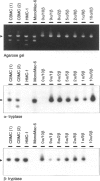Abstract
The present study sought to determine the expression of alpha- and beta-tryptase in in vitro differentiated human cord blood derived mast cells. We also analysed the glycosaminoglycan composition and the phenotype of the cells. The major protease in human mast cells is tryptase, and cDNAs for two different human tryptases have been characterized, the so-called alpha- and beta-tryptase. By reverse transcriptase-polymerase chain reaction (RT-PCR) we could show that stem cell factor (SCF)-dependent cord blood derived mast cells express both alpha- and beta-tryptase. Furthermore, the cells were stained with a monoclonal antibody (mAb) against tryptase, and the tryptase was enzymatically active cleaving the substrate Z-Gly-Pro-Arg- methoxy-2- naphthylamide (MNA). The majority of the cord blood derived mast cells could also be stained with mAbs against chymase, cathepsin G and CD68. They also expressed Kit/SCFR (CD117), CD13, CD29 and CD45 on the cell surface. The proteoglycan-derived polysaccharide composition of the cells was estimated to be 25-35% of heparin origin and 65-75% of chondroitin sulphate origin. Hence, the cord blood derived mast cells exhibit a phenotype in common with the so-called MCTC type of human mast cells.
Full text
PDF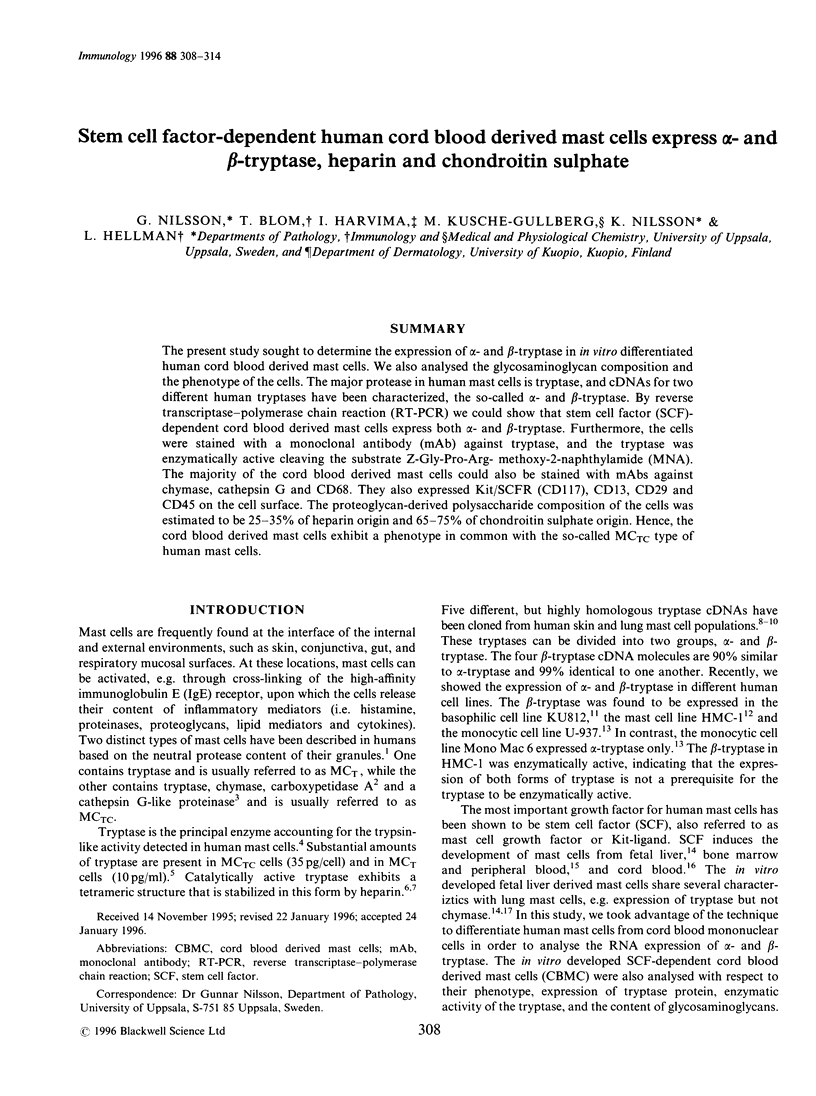
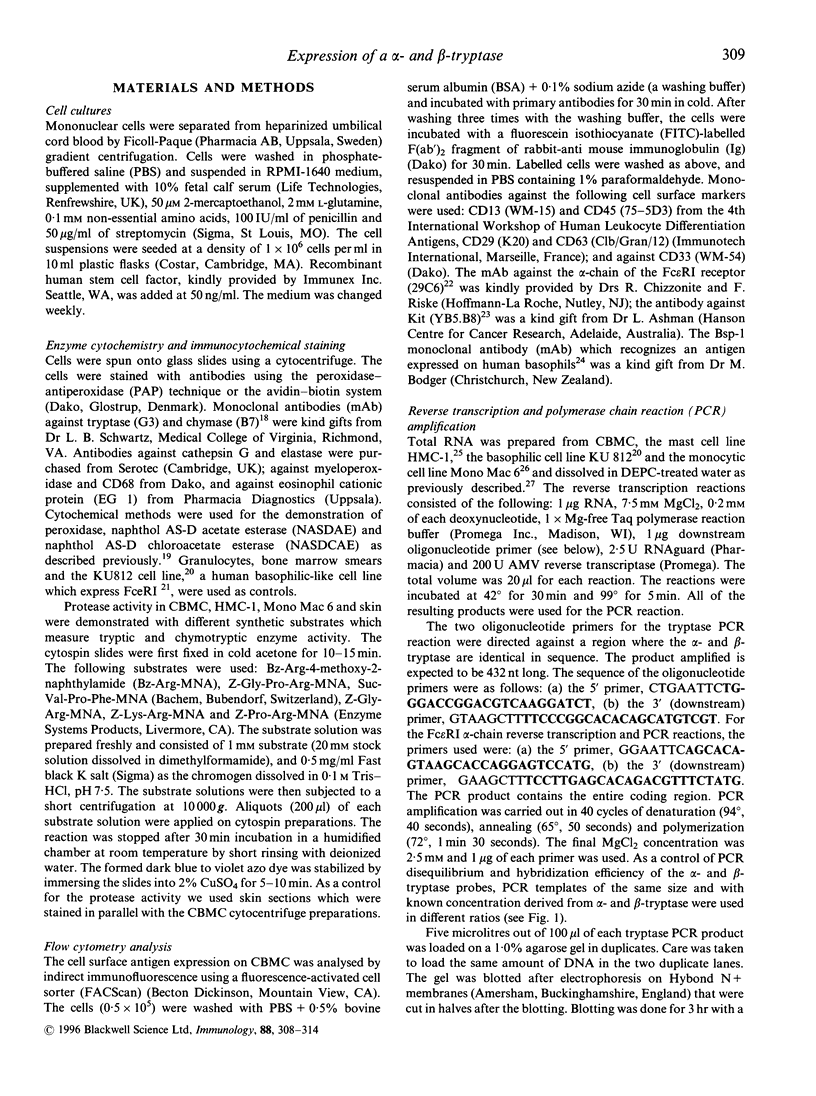

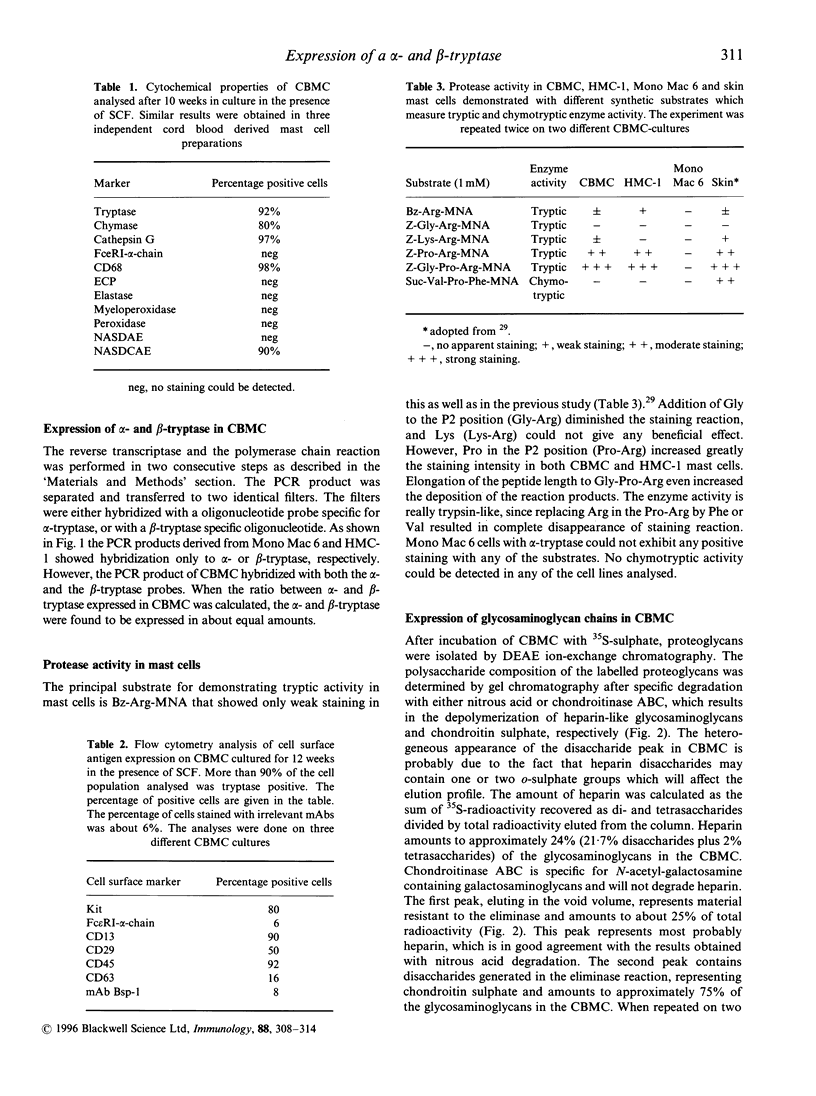

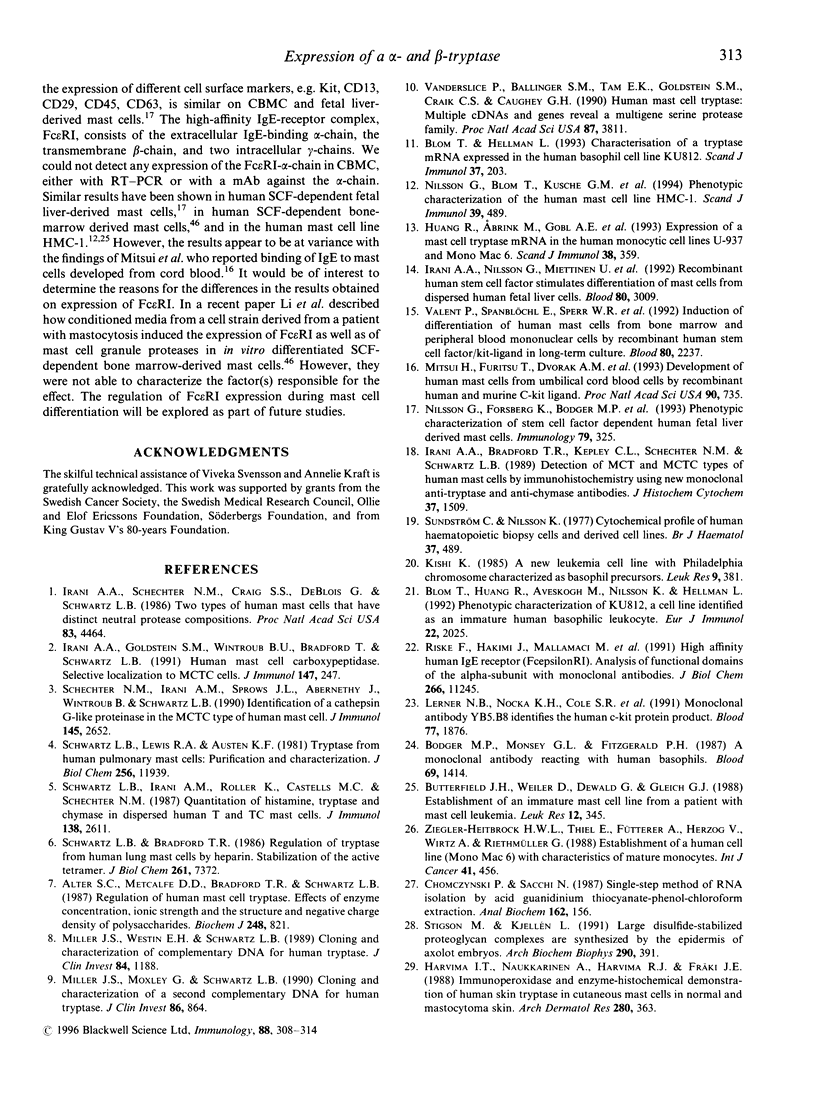

Images in this article
Selected References
These references are in PubMed. This may not be the complete list of references from this article.
- Agis H., Willheim M., Sperr W. R., Wilfing A., Krömer E., Kabrna E., Spanblöchl E., Strobl H., Geissler K., Spittler A. Monocytes do not make mast cells when cultured in the presence of SCF. Characterization of the circulating mast cell progenitor as a c-kit+, CD34+, Ly-, CD14-, CD17-, colony-forming cell. J Immunol. 1993 Oct 15;151(8):4221–4227. [PubMed] [Google Scholar]
- Alter S. C., Metcalfe D. D., Bradford T. R., Schwartz L. B. Regulation of human mast cell tryptase. Effects of enzyme concentration, ionic strength and the structure and negative charge density of polysaccharides. Biochem J. 1987 Dec 15;248(3):821–827. doi: 10.1042/bj2480821. [DOI] [PMC free article] [PubMed] [Google Scholar]
- Blom T., Hellman L. Characterization of a tryptase mRNA expressed in the human basophil cell line KU812. Scand J Immunol. 1993 Feb;37(2):203–208. doi: 10.1111/j.1365-3083.1993.tb01757.x. [DOI] [PubMed] [Google Scholar]
- Blom T., Huang R., Aveskogh M., Nilsson K., Hellman L. Phenotypic characterization of KU812, a cell line identified as an immature human basophilic leukocyte. Eur J Immunol. 1992 Aug;22(8):2025–2032. doi: 10.1002/eji.1830220811. [DOI] [PubMed] [Google Scholar]
- Bodger M. P., Mounsey G. L., Nelson J., Fitzgerald P. H. A monoclonal antibody reacting with human basophils. Blood. 1987 May;69(5):1414–1418. [PubMed] [Google Scholar]
- Butterfield J. H., Weiler D., Dewald G., Gleich G. J. Establishment of an immature mast cell line from a patient with mast cell leukemia. Leuk Res. 1988;12(4):345–355. doi: 10.1016/0145-2126(88)90050-1. [DOI] [PubMed] [Google Scholar]
- Chomczynski P., Sacchi N. Single-step method of RNA isolation by acid guanidinium thiocyanate-phenol-chloroform extraction. Anal Biochem. 1987 Apr;162(1):156–159. doi: 10.1006/abio.1987.9999. [DOI] [PubMed] [Google Scholar]
- Craig S. S., Irani A. M., Metcalfe D. D., Schwartz L. B. Ultrastructural localization of heparin to human mast cells of the MCTC and MCT types by labeling with antithrombin III-gold. Lab Invest. 1993 Nov;69(5):552–561. [PubMed] [Google Scholar]
- Harvima I. T., Naukkarinen A., Harvima R. J., Fräki J. E. Immunoperoxidase and enzyme-histochemical demonstration of human skin tryptase in cutaneous mast cells in normal and mastocytoma skin. Arch Dermatol Res. 1988;280(6):363–370. doi: 10.1007/BF00426615. [DOI] [PubMed] [Google Scholar]
- Harvima I. T., Naukkarinen A., Harvima R. J., Horsmanheimo M. Enzyme- and immunohistochemical localization of mast cell tryptase in psoriatic skin. Arch Dermatol Res. 1989;281(6):387–391. doi: 10.1007/BF00455322. [DOI] [PubMed] [Google Scholar]
- Harvima I. T., Naukkarinen A., Paukkonen K., Harvima R. J., Aalto M. L., Schwartz L. B., Horsmanheimo M. Mast cell tryptase and chymase in developing and mature psoriatic lesions. Arch Dermatol Res. 1993;285(4):184–192. doi: 10.1007/BF00372007. [DOI] [PubMed] [Google Scholar]
- Harvima I. T., Schechter N. M., Harvima R. J., Fräki J. E. Human skin tryptase: purification, partial characterization and comparison with human lung tryptase. Biochim Biophys Acta. 1988 Nov 2;957(1):71–80. doi: 10.1016/0167-4838(88)90158-6. [DOI] [PubMed] [Google Scholar]
- Holness C. L., Simmons D. L. Molecular cloning of CD68, a human macrophage marker related to lysosomal glycoproteins. Blood. 1993 Mar 15;81(6):1607–1613. [PubMed] [Google Scholar]
- Horny H. P., Schaumburg-Lever G., Bolz S., Geerts M. L., Kaiserling E. Use of monoclonal antibody KP1 for identifying normal and neoplastic human mast cells. J Clin Pathol. 1990 Sep;43(9):719–722. doi: 10.1136/jcp.43.9.719. [DOI] [PMC free article] [PubMed] [Google Scholar]
- Huang R., Abrink M., Gobl A. E., Nilsson G., Aveskogh M., Larsson L. G., Nilsson K., Hellman L. Expression of a mast cell tryptase in the human monocytic cell lines U-937 and Mono Mac 6. Scand J Immunol. 1993 Oct;38(4):359–367. doi: 10.1111/j.1365-3083.1993.tb01738.x. [DOI] [PubMed] [Google Scholar]
- Irani A. A., Schechter N. M., Craig S. S., DeBlois G., Schwartz L. B. Two types of human mast cells that have distinct neutral protease compositions. Proc Natl Acad Sci U S A. 1986 Jun;83(12):4464–4468. doi: 10.1073/pnas.83.12.4464. [DOI] [PMC free article] [PubMed] [Google Scholar]
- Irani A. M., Bradford T. R., Kepley C. L., Schechter N. M., Schwartz L. B. Detection of MCT and MCTC types of human mast cells by immunohistochemistry using new monoclonal anti-tryptase and anti-chymase antibodies. J Histochem Cytochem. 1989 Oct;37(10):1509–1515. doi: 10.1177/37.10.2674273. [DOI] [PubMed] [Google Scholar]
- Irani A. M., Goldstein S. M., Wintroub B. U., Bradford T., Schwartz L. B. Human mast cell carboxypeptidase. Selective localization to MCTC cells. J Immunol. 1991 Jul 1;147(1):247–253. [PubMed] [Google Scholar]
- Irani A. M., Nilsson G., Miettinen U., Craig S. S., Ashman L. K., Ishizaka T., Zsebo K. M., Schwartz L. B. Recombinant human stem cell factor stimulates differentiation of mast cells from dispersed human fetal liver cells. Blood. 1992 Dec 15;80(12):3009–3021. [PubMed] [Google Scholar]
- Kishi K. A new leukemia cell line with Philadelphia chromosome characterized as basophil precursors. Leuk Res. 1985;9(3):381–390. doi: 10.1016/0145-2126(85)90060-8. [DOI] [PubMed] [Google Scholar]
- Lerner N. B., Nocka K. H., Cole S. R., Qiu F. H., Strife A., Ashman L. K., Besmer P. Monoclonal antibody YB5.B8 identifies the human c-kit protein product. Blood. 1991 May 1;77(9):1876–1883. [PubMed] [Google Scholar]
- Li L., Macpherson J. J., Adelstein S., Bunn C. L., Atkinson K., Phadke K., Krilis S. A. Conditioned media from a cell strain derived from a patient with mastocytosis induces preferential development of cells that possess high affinity IgE receptors and the granule protease phenotype of mature cutaneous mast cells. J Biol Chem. 1995 Feb 3;270(5):2258–2263. doi: 10.1074/jbc.270.5.2258. [DOI] [PubMed] [Google Scholar]
- Miller J. S., Moxley G., Schwartz L. B. Cloning and characterization of a second complementary DNA for human tryptase. J Clin Invest. 1990 Sep;86(3):864–870. doi: 10.1172/JCI114786. [DOI] [PMC free article] [PubMed] [Google Scholar]
- Miller J. S., Westin E. H., Schwartz L. B. Cloning and characterization of complementary DNA for human tryptase. J Clin Invest. 1989 Oct;84(4):1188–1195. doi: 10.1172/JCI114284. [DOI] [PMC free article] [PubMed] [Google Scholar]
- Mitsui H., Furitsu T., Dvorak A. M., Irani A. M., Schwartz L. B., Inagaki N., Takei M., Ishizaka K., Zsebo K. M., Gillis S. Development of human mast cells from umbilical cord blood cells by recombinant human and murine c-kit ligand. Proc Natl Acad Sci U S A. 1993 Jan 15;90(2):735–739. doi: 10.1073/pnas.90.2.735. [DOI] [PMC free article] [PubMed] [Google Scholar]
- Nilsson G., Blom T., Kusche-Gullberg M., Kjellén L., Butterfield J. H., Sundström C., Nilsson K., Hellman L. Phenotypic characterization of the human mast-cell line HMC-1. Scand J Immunol. 1994 May;39(5):489–498. doi: 10.1111/j.1365-3083.1994.tb03404.x. [DOI] [PubMed] [Google Scholar]
- Nilsson G., Butterfield J. H., Nilsson K., Siegbahn A. Stem cell factor is a chemotactic factor for human mast cells. J Immunol. 1994 Oct 15;153(8):3717–3723. [PubMed] [Google Scholar]
- Nilsson G., Forsberg K., Bodger M. P., Ashman L. K., Zsebo K. M., Ishizaka T., Irani A. M., Schwartz L. B. Phenotypic characterization of stem cell factor-dependent human foetal liver-derived mast cells. Immunology. 1993 Jun;79(2):325–330. [PMC free article] [PubMed] [Google Scholar]
- Nilsson G., Miettinen U., Ishizaka T., Ashman L. K., Irani A. M., Schwartz L. B. Interleukin-4 inhibits the expression of Kit and tryptase during stem cell factor-dependent development of human mast cells from fetal liver cells. Blood. 1994 Sep 1;84(5):1519–1527. [PubMed] [Google Scholar]
- Nilsson G., Nilsson K. Effects of interleukin (IL)-13 on immediate-early response gene expression, phenotype and differentiation of human mast cells. Comparison with IL-4. Eur J Immunol. 1995 Mar;25(3):870–873. doi: 10.1002/eji.1830250337. [DOI] [PubMed] [Google Scholar]
- Parwaresch M. R., Radzun H. J., Kreipe H., Hansmann M. L., Barth J. Monocyte/macrophage-reactive monoclonal antibody Ki-M6 recognizes an intracytoplasmic antigen. Am J Pathol. 1986 Oct;125(1):141–151. [PMC free article] [PubMed] [Google Scholar]
- Riske F., Hakimi J., Mallamaci M., Griffin M., Pilson B., Tobkes N., Lin P., Danho W., Kochan J., Chizzonite R. High affinity human IgE receptor (Fc epsilon RI). Analysis of functional domains of the alpha-subunit with monoclonal antibodies. J Biol Chem. 1991 Jun 15;266(17):11245–11251. [PubMed] [Google Scholar]
- Rottem M., Okada T., Goff J. P., Metcalfe D. D. Mast cells cultured from the peripheral blood of normal donors and patients with mastocytosis originate from a CD34+/Fc epsilon RI- cell population. Blood. 1994 Oct 15;84(8):2489–2496. [PubMed] [Google Scholar]
- Schechter N. M., Irani A. M., Sprows J. L., Abernethy J., Wintroub B., Schwartz L. B. Identification of a cathepsin G-like proteinase in the MCTC type of human mast cell. J Immunol. 1990 Oct 15;145(8):2652–2661. [PubMed] [Google Scholar]
- Schechter N. M., Sprows J. L., Schoenberger O. L., Lazarus G. S., Cooperman B. S., Rubin H. Reaction of human skin chymotrypsin-like proteinase chymase with plasma proteinase inhibitors. J Biol Chem. 1989 Dec 15;264(35):21308–21315. [PubMed] [Google Scholar]
- Schwartz L. B., Bradford T. R. Regulation of tryptase from human lung mast cells by heparin. Stabilization of the active tetramer. J Biol Chem. 1986 Jun 5;261(16):7372–7379. [PubMed] [Google Scholar]
- Schwartz L. B., Irani A. M., Roller K., Castells M. C., Schechter N. M. Quantitation of histamine, tryptase, and chymase in dispersed human T and TC mast cells. J Immunol. 1987 Apr 15;138(8):2611–2615. [PubMed] [Google Scholar]
- Schwartz L. B., Lewis R. A., Austen K. F. Tryptase from human pulmonary mast cells. Purification and characterization. J Biol Chem. 1981 Nov 25;256(22):11939–11943. [PubMed] [Google Scholar]
- Stevens R. L., Fox C. C., Lichtenstein L. M., Austen K. F. Identification of chondroitin sulfate E proteoglycans and heparin proteoglycans in the secretory granules of human lung mast cells. Proc Natl Acad Sci U S A. 1988 Apr;85(7):2284–2287. doi: 10.1073/pnas.85.7.2284. [DOI] [PMC free article] [PubMed] [Google Scholar]
- Stigson M., Kjellén L. Large disulfide-stabilized proteoglycan complexes are synthesized by the epidermis of axolotl embryos. Arch Biochem Biophys. 1991 Nov 1;290(2):391–396. doi: 10.1016/0003-9861(91)90557-y. [DOI] [PubMed] [Google Scholar]
- Sundström C., Nilsson K. Cytochemical profile of human haematopoietic biopsy cells and derived cell lines. Br J Haematol. 1977 Dec;37(4):489–501. doi: 10.1111/j.1365-2141.1977.tb01022.x. [DOI] [PubMed] [Google Scholar]
- Thompson H. L., Schulman E. S., Metcalfe D. D. Identification of chondroitin sulfate E in human lung mast cells. J Immunol. 1988 Apr 15;140(8):2708–2713. [PubMed] [Google Scholar]
- Valent P., Spanblöchl E., Sperr W. R., Sillaber C., Zsebo K. M., Agis H., Strobl H., Geissler K., Bettelheim P., Lechner K. Induction of differentiation of human mast cells from bone marrow and peripheral blood mononuclear cells by recombinant human stem cell factor/kit-ligand in long-term culture. Blood. 1992 Nov 1;80(9):2237–2245. [PubMed] [Google Scholar]
- Vanderslice P., Ballinger S. M., Tam E. K., Goldstein S. M., Craik C. S., Caughey G. H. Human mast cell tryptase: multiple cDNAs and genes reveal a multigene serine protease family. Proc Natl Acad Sci U S A. 1990 May;87(10):3811–3815. doi: 10.1073/pnas.87.10.3811. [DOI] [PMC free article] [PubMed] [Google Scholar]
- Xia H. Z., Kepley C. L., Sakai K., Chelliah J., Irani A. M., Schwartz L. B. Quantitation of tryptase, chymase, Fc epsilon RI alpha, and Fc epsilon RI gamma mRNAs in human mast cells and basophils by competitive reverse transcription-polymerase chain reaction. J Immunol. 1995 May 15;154(10):5472–5480. [PubMed] [Google Scholar]
- Ziegler-Heitbrock H. W., Thiel E., Fütterer A., Herzog V., Wirtz A., Riethmüller G. Establishment of a human cell line (Mono Mac 6) with characteristics of mature monocytes. Int J Cancer. 1988 Mar 15;41(3):456–461. doi: 10.1002/ijc.2910410324. [DOI] [PubMed] [Google Scholar]



